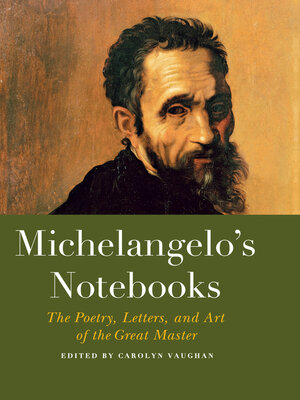Michelangelo's Notebooks
ebook ∣ The Drawing, Notes, Poetry, and Letters of the Great Master · Notebook Series
By Carolyn Vaughan

Sign up to save your library
With an OverDrive account, you can save your favorite libraries for at-a-glance information about availability. Find out more about OverDrive accounts.
Find this title in Libby, the library reading app by OverDrive.



Search for a digital library with this title
Title found at these libraries:
| Library Name | Distance |
|---|---|
| Loading... |
Michelangelo's Notebooks is an intimate celebration of the artist's sketches, architectural drawings, letters, and love poems.
Michelangelo Buonarroti is considered to be one of the greatest artists of the sixteenth century, not only in painting but in writing and poetry as well. He filled hundreds of sheets of paper with exquisite drawings, many of which would eventually become some of the most celebrated masterpieces of all time, and he wrote over 300 poems and sonnets on admiration and spirituality.
Organized chronologically, Michelangelo's Notebooks is an illustrated record of the artist's life and work, and combines the artists's own words with his sketches and finished compositions. His letters about the Sistine Chapel and Pope Julius, for example, are illustrated with sketches that he produced while he was writing.
Edited and curated by Carolyn Vaughan, former editor at the Metropolitan Museum of Art, she provides fascinating commentary and insights into the material presented throughout the book.
Michelangelo Buonarroti is considered to be one of the greatest artists of the sixteenth century, not only in painting but in writing and poetry as well. He filled hundreds of sheets of paper with exquisite drawings, many of which would eventually become some of the most celebrated masterpieces of all time, and he wrote over 300 poems and sonnets on admiration and spirituality.
Organized chronologically, Michelangelo's Notebooks is an illustrated record of the artist's life and work, and combines the artists's own words with his sketches and finished compositions. His letters about the Sistine Chapel and Pope Julius, for example, are illustrated with sketches that he produced while he was writing.
Edited and curated by Carolyn Vaughan, former editor at the Metropolitan Museum of Art, she provides fascinating commentary and insights into the material presented throughout the book.







